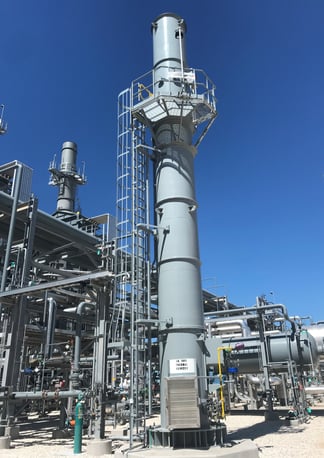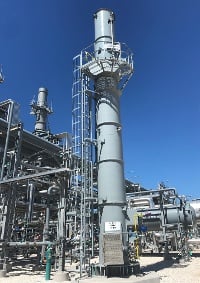Catalytic Products International (CPI) installed a Thermal Combustor System (TCS) at a Southwestern fractionator for the treatment of waste gas containing hydrocarbons, aromatics, and hydrogen sulfide emitted during an acid gas separation process.

Natural gas coming directly from a well contains many natural gas liquids (NGLs) that are commonly removed. In most instances, natural gas liquids have a higher value as separate products, and it is thus economical to remove them from the gas stream. Natural gas processing consists of separating all of the various hydrocarbons and fluids from the pure natural gas, to produce what is known as ‘pipeline quality’ or purified dry natural gas.
Once NGLs have been removed from the natural gas, the mixed stream of different NGLs are separated out from the natural gas stream using a separation process known as fractionation. In addition to water, oil, and NGL removal, one of the most important parts of gas processing involves the removal of sulfur and carbon dioxide from the natural gas. This natural gas, because of the rotten smell provided by its sulfur content, is commonly called ‘sour gas’. Sour gas is undesirable because the sulfur compounds it contains can be highly corrosive and extremely harmful to breathe.
The process for removing acid gases, CO2, and hydrogen sulfide from sour gas is commonly referred to as ‘sweetening’ the gas. During an amine process the sour gas is run through a tower containing an amine solution. The effluent natural gas is then sent for processing while the amine solution is sent to be regenerated. The regeneration process removes the acid gases from the amine solution, allowing it to be reused, but the process creates tail gas which may require control.
The Thermal Combustor System will control the emissions from two gas streams, an amine flash gas and an amine acid gas. The Thermal Combustor System will destroy the emissions with 99.5% destruction rate efficiency (DRE).
Thermal Combustor Systems (TCS) are fully enclosed flare designs that hide the flame while thermally combusting the vapor gas steam. This supports a safe design when compared to exposed flame flare systems and allows installation in numerous areas of any plant. TCS allow combustion of hydrocarbon vapor mixtures that have varying energy content where enclosed flares may fail. Thermal Combustor Systems are custom designed for a particular process stream and can include a forced or natural draft system along with a full complement of auxiliary devices to aid in performance and safety.
The Thermal Combustor System utilizes a superior combustion and dwell chamber coupled with a vertical design for efficient combustion. The TCS operation sequence begins by purging the entire system with fresh air. After purge, the TCS pilot and main burners are ignited and held in place until appropriate flame scanning safeties are met. Once flame safety requirements are met, process gas is introduced to the TCS. The TCS system automatically adjusts to different volumes, concentrations, and heat values of the process gas. If the process gas does not have the energy to support combustion, natural gas may be added as a support fuel.
The introduction of process gas increases the internal temperature within the combustion chamber. To control the temperature and facilitate combustion fresh air is added to the system. The fresh air can be naturally aspirated or forced into the system. The combustion air added into the system ensures adequate mixing, sufficient oxygen, and controlled temperature providing optimum destruction efficiency.
Catalytic Products International (CPI) worked closely with the customer’s engineering consultant providing the design, supply and startup of the Thermal Combustor System. The Thermal Combustor System was custom designed for the particular gas streams and included a full complement of auxiliary devices to aid in performance, safety, and self- diagnostics. Custom features include electrical components designed for Class 1 Div 2 and a Temperature Safety System. A stack analyzer system was added to continuously monitor oxygen concentration and communicate with the plant Distributed Control System (DCS) for data historization.
CPI has been “Enabling Clean Production Since 1969” and continues as a leading supplier of air pollution control equipment. CPI is at the forefront in providing industries including the natural gas industry with solutions to their air pollution control needs.
Today, CPI partners with its customers as a trusted resource in resolving the most complex air pollution and energy conservation problems. We provide our customers with innovative and cost-conscious solutions to their most complex VOC, NOx, and Odor pollution challenges. Our equipment is also at work meeting energy conservation strategies and minimizing greenhouse gas (GHG) emissions.








